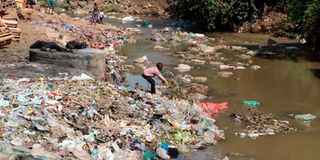World’s rivers polluted with toxic levels of drugs

What you need to know:
- The study, published in the Proceedings of the National Academy of Sciences and released in February 14 , warns that pollution of the world’s rivers by medicinal chemicals is a global problem.
- The most common contaminants in the rivers monitored in Kenya included Caffeine, Carbamazepine, Cetirizine, Fluconazole, Sulfamethoxazole, Metronidazole and Metformin.
More than a quarter of the world’s rivers contain potentially toxic levels of pharmaceutical drugs, a report has shown.
Researchers from around the world surveyed more than 1,000 locations on 258 rivers in 104 countries, including Kenya. The sampling included 24 countries in Africa and 227 sampling sites.
At 25.7 per cent of the sampling sites, concentrations of at least one substance were greater than concentrations considered safe for aquatic organisms and were therefore deemed potentially toxic.
“We’ve known for over two decades now that pharmaceuticals make their way into the aquatic environment, where they may affect the biology of living organisms,” said project co-leader John Wilkinson of the University of York in the UK, where the samples were analysed.
The study, published in the Proceedings of the National Academy of Sciences and released in February 14 , warns that pollution of the world’s rivers by medicinal chemicals is a global problem.
The analysis at the University of York found pharmaceutical pollution in rivers on every continent, including Antarctica.
Nicotine and cotinine, caffeine, and paracetamol are turning up everywhere.
Only two places were unpolluted – Iceland and a Venezuelan village where the indigenous people do not use modern medicines.
For the study, Dr Wilkinson and colleagues analysed 61 active pharmaceutical ingredients (APIs) concentrations in1,052 locations along 258 rivers located in 104 countries across all continents.
According to the team, rivers in 36 of these countries had never previously been monitored for pharmaceuticals.
The highest cumulative API concentrations were observed in sub-Saharan Africa, South Asia, and South America.
According to the study, the most contaminated sites were in low- to middle-income countries and were associated with poor wastewater, waste management infrastructure and pharmaceutical manufacturing.
Rivers in Pakistan, India, Bolivia, Ethiopia and Nigeria were among the most polluted, with waterways in Iceland, Norway, and the Amazon rainforest at the other end of the scale along with some cities with sophisticated wastewater treatment (Basel in Switzerland).
The most frequently detected APIs were carbamazepine, metformin and caffeine (a compound also arising from lifestyle use), which were detected at over half of the sites monitored.
“One of the largest problems we have faced in tackling this issue is that we have not been very representative when monitoring these contaminants, with almost all of the data focused on a select few areas in North America, Western Europe, and China,” said Dr Wilkinson.
The researchers hope that by increasing the monitoring of pharmaceuticals in the environment, they can develop strategies to limit the effects potentially caused by the presence of pollutants.
In Kenya, the researchers looked at Ngong River and Nairobi River at eight sites. The two are tributaries of the Nairobi River basin.
In Kikuyu town, a one-meter-wide section of Nairobi River, where the sample was taken, flowed through scattered residences and agricultural areas, where irrigation is ongoing.
At Chiromo, near the university campus, the three-meter-wide river with riparian vegetation was littered with plastics.
Another point was at the ShauriMoyo / Eastleigh bridge, where the river has a stench and is littered with plastics. Raw sewage discharges to the river and there are a lot of apartments in the area.
The researchers found sewage discharge flowing in the river at the bridge beyond Moi Airbase littered with plastics.
At another point where the river was flowing fast, raw sewage was being dumped by the exhaust tanks near the bridge and farming and irrigation were being done in the area.
In Ngong River, the researchers found garbage dumped at the river bank.
The most common contaminants in the rivers monitored in Kenya included Caffeine, Carbamazepine, Cetirizine, Fluconazole, Sulfamethoxazole, Metronidazole and Metformin.
Of the four APIs detected across all continents, all were considered either lifestyle compounds or over-the-counter APIs: Caffeine (stimulant and lifestyle compound), Nicotine (stimulant and lifestyle compound) Acetaminophen/paracetamol (analgesic) and Cotinine (metabolite of a stimulant and lifestyle compound).
According to the study, the large range in API concentrations is likely contributed by the relative affordability and differences in regulatory oversight of the accessibility of these medicines.
The researchers found out that regions with less regulated access to medicines (for instance regions where antibiotics are available over the counter) generally revealed greater variability and range of API concentrations
This trend was most notable for antibiotic medicines in African countries, which showed the highest variability (four orders-of-magnitude) and concentrations (threefold higher on average than the next closest continent) worldwide.
“This may, in part, be driven by a general lack of enforceable regulatory oversight for proper antibiotic sales and use in human and veterinary applications, “the study noted.





